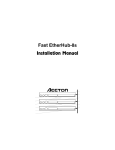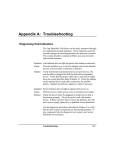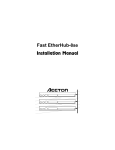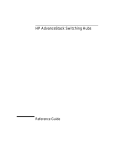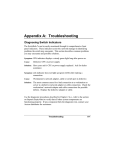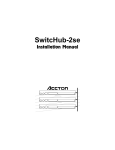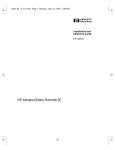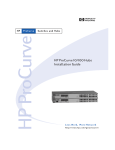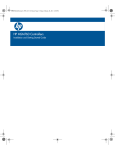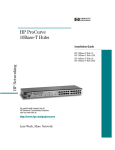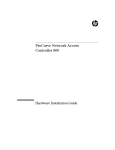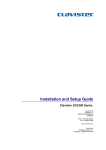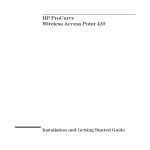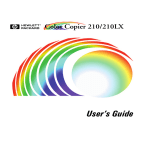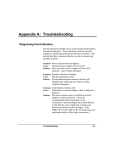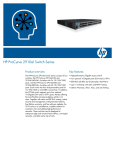Download HP 100BaseT Reference Guide
Transcript
HP AdvanceStack 100Base-T Hub-8TXE Installation and Reference Guide © Copyright 1996 Hewlett-Packard Company All Rights Reserved Reproduction, adaptation, or translation without prior written permission is prohibited, except as allowed under the copyright laws. Publication Number J3235-90001 Edition 1 November 1996 Applicable Product HP J3235A AdvanceStack 100Base-T Hub-8TXE Disclaimer The information contained in this document is subject to change without notice. HEWLETT-PACKARD COMPANY MAKES NO WARRANTY OF ANY KIND WITH REGARD TO THIS MATERIAL, INCLUDING, BUT NOT LIMITED TO, THE IMPLIED WARRANTIES OF MERCHANTABILITY AND FITNESS FOR A PARTICULAR PURPOSE. Hewlett-Packard shall not be liable for errors contained herein or for incidental or consequential damages in connection with the furnishing, performance, or use of this material. Hewlett-Packard assumes no responsibility for the use or reliability of its software on equipment that is not furnished by Hewlett-Packard. Warranty See the warranty booklet included with the product. A copy of the specific warranty terms applicable to your Hewlett-Packard product and replacement parts can be obtained from your HP sales and service office or HP authorized reseller. Hewlett-Packard Company 8000 Foothills Boulevard, m/s 5551 Roseville, California 95747-5551 http://www.hp.com/go/network_city Package Contents Carefully unpack the contents of the package and verify them against the checklist given below. Package Checklist æ HP AdvanceStack 100Base-T Hub-8TXE (Part No. HP J3235A) æ Power cord, one of the following: Australia/New Zealand (8120-6810) Denmark (8120-6814) Europe (8120-6811) Japan (8120-6798) Switzerland (8120-6815) United States/Canada (8120-6812) United Kingdom (8120-6809) æ Four rubber foot pads æ Installation and Reference Guide (J2325-90001) æ Warranty booklet Please inform your dealer immediately should there be any wrong, missing, or damaged parts. If possible, retain the carton, including the original packing materials. Use them again to repack the unit in case there is a need to return it for repair. Package Contents i Quick Installation The HP J3235A AdvanceStack 100Base-T Hub-8TXE contains 8 100Base-TX Fast Ethernet ports. The smart design built into the front display panel provides a friendly interface that simplifies installation and network troubleshooting. If you are already familiar with basic network operations, you should be able to install this hub as described below: 1. Unpack the HP Hub-8TXE. 2. Find a location close to the network devices you need to connect, and within easy reach of an electrical outlet. 3. Mount the hub on a desktop or any other flat surface. If you are installing multiple hubs, you can stack them on top of each other (after attaching the foot pads). 4. Connect any devices that use a standard network interface to the RJ-45 (MDI-X) ports (e.g., a workstation, server, bridge or router). Use 100W Category 5 STP or 100W Category 5 UTP cable to connect to the hub, and be sure the length of any twisted-pair connection does not exceed 100 meters. Refer to Chapter 3 for sample configurations. 5. To cascade to another hub or switch, run straight-through twisted-pair cable from the (8MDI) cascade port on this switch to any (MDI-X) port on the other device (or vice versa). Refer to Figure 3.2. If necessary, you can also cascade between two ports using crossover cable. However, be sure not to exceed the maximum length between end nodes as described in Chapter 2. Quick Installation iii HP Hub-8TXE Installation and Reference Guide 6. This hub can serve as a stand-alone repeater for small networks, can be cascaded with compatible devices (e.g., Fast Ethernet hub or switch), or can be connected to a network interconnection device (e.g., Fast Ethernet bridge or router). 7. Verify network communications by ensuring that: • you have made all the necessary connections • you can access any connected resources • the hub’s indicators are functioning properly If you encounter any problems in installing the HP Hub-8TXE, refer to Chapter 2 for a detailed description of installation procedures, Chapter 3 for sample configurations, or Appendix A for help in troubleshooting. Note: Refer to Chapter 2 for a more detailed description of calculating the maximum cable length permitted between two end nodes for Fast Ethernet. iv Quick Installation About this Guide This guide is designed for the experienced network installer. It describes how to install and operate the HP Hub-8TXE. After reading this manual, you should be able to use the front display panel and configure options to manage all your network connections. This manual covers the following topics: Chapter 1 - Product Overview Brief description of Fast Ethernet, followed by a description of this hub and a summary of its important features and specifications. Chapter 2 - Installing the System Installing an HP Hub-8TXE and making basic network connections. Chapter 3 - Configuring the Network Shows sample network configurations for a local area network. Chapter 4 - Hardware Reference Detailed description of indicator panel and ports. Appendices Troubleshooting, cable assignments, and product specifications. About this Guide v Contents Chapter 1: Product Overview ................................................. 1-1 Introduction to Fast Ethernet .....................................................................................1-1 HP Hub-8TXE...........................................................................................................1-1 Basic Features ...........................................................................................................1-2 Chapter 2: Installing the System............................................ 2-1 Pre-Installation Requirements ...................................................................................2-1 Connecting the Hub System ......................................................................................2-2 Making a Connection via an MDI-X Port ............................................................2-2 Making a Connection via the MDI Cascade Port .................................................2-3 Distance Limit for Fast Ethernet Cabling .............................................................2-3 Providing Power to the Hub ......................................................................................2-4 Verifying Port Status .................................................................................................2-4 Verifying System Operation......................................................................................2-5 Chapter 3: Configuring the Network...................................... 3-1 Stand-Alone...............................................................................................................3-1 Connecting Multiple Hubs ........................................................................................3-2 Chapter 4: Hardware Reference............................................. 4-1 Front Panel ...............................................................................................................4-1 Power ..............................................................................................................4-2 Statistical Display for System Performance....................................................4-3 Port Status Display ...............................................................................................4-4 RJ-45 Fast Ethernet Ports .....................................................................................4-5 Rear Panel ...............................................................................................................4-6 Power Socket........................................................................................................4-6 vii HP Hub-8TXE Installation and Reference Guide Appendix A: Troubleshooting................................................ A-1 Diagnosing Hub Indicators........................................................................................A-1 System Diagnostics ...................................................................................................A-2 Power and Cooling Problems ...............................................................................A-2 Installation ............................................................................................................A-2 Physical Configuration .........................................................................................A-3 Hub Integrity ........................................................................................................A-3 Appendix B: Port and Cable Assignments............................. B-1 RJ-45 Port ...............................................................................................................B-1 Appendix C: Specifications.................................................... C-1 Product Specifications...............................................................................................C-1 Appendix D: Safety and Regulatory Statements .................. D-1 Power Precautions ......................................................................................................D-1 Safety Information......................................................................................................D-2 Informations concernant la sécurité............................................................................D-3 Hinweise zur Sicherheit..............................................................................................D-4 Considerazioni sulla sicurezza ...................................................................................D-5 Consideraciones sobre seguridad ...............................................................................D-6 Safety Information (Japanese) ....................................................................................D-7 Regulatory Statements................................................................................................D-8 Appendix E: Product Support Services ................................ E-1 Glossary Index viii Contents HP Hub-8TXE Installation and Reference Guide List of Figures Figure 3.1 Figure 3.2 Figure 4.1 Figure 4.2 Figure 4.3 Figure B-1 Stand-Alone Configuration ....................................................................3-1 Multiple Hub Configuration Using the Cascade Port.............................3-2 Front Panel .............................................................................................4-1 Indicators ...............................................................................................4-2 Rear Panel ..............................................................................................4-6 RJ-45 Connector (on the Hub Side) .......................................................B-1 List of Tables Table B-1 RJ-45 Pin Assignments............................................................................B-1 Contents ix Chapter 1: Product Overview Introduction to Fast Ethernet Standard 10 Mbits/s Ethernet has served well for past generations of 286 and 386 machines performing simple file transfers. However, with the inevitable growth in corporate network size and the introduction of fully-functional 32-bit PC architectures, and operating systems running complex applications, 10 Mbits/s Ethernet has become a serious bottleneck. With the recent flood of choices for upgrading media bandwidth, 100 Mbits/s Fast Ethernet has become the most popular because of its low cost, compatibility with existing Ethernet applications, and the fact that it can run on top of an installed base of twisted-pair cabling. Fast Ethernet can be easily integrated into an existing 10 Mbits/s Ethernet environment with no need for protocol translation or changes to network software. HP Hub-8TXE The HP J323SA AdvanceStack 100Base-TX Hub-8TXE includes 8 Fast Ethernet ports. It provides a friendly design that simplifies installation and network troubleshooting. The indicator panel includes Utilization and Collision rate LEDs, as well as Partition, Link and Traffic LEDs to ease network management. The HP Hub-8TXE can be used to relieve common network congestion, regardless of whether it is caused by too many stations contending for limited bandwidth or by a server that is supporting too many users. It can significantly improve access both to key servers and to the network backbone. This hub not only delivers a vast improvement in network response time, but helps you maintain outstanding performance as your user community continues to grow. Product Overview 1-1 HP Hub-8TXE Installation and Reference Guide Basic Features • Transmits data at 100 Mbits/s for demanding applications • Conforms to the IEEE 802.3u repeater specification for 100Base-TX • Provides 8 RJ-45 100Base-TX ports (using MDI-X wiring) • Port 8 can serve as an MDI-X port (for connection to network devices such as workstations or servers) or as an MDI daisy-chain port (for connection to network devices such as hubs or switches), eliminating the need for crossover cables • Supports 100Ω Category 5 shielded or unshielded cable (STP or UTP) • Friendly design that monitors network utilization, collisions, link and port partition status • LED indicator panel includes Utilization and Collision rate indicators for reporting hub activity and facilitating problem diagnosis • Automatically partitions bad ports to protect the network system • Automatic polarity detection and correction permits automatic adjustment for wiring errors • Plug-and-play operation The HP Hub-8TXE also supports the following basic system safeguards: • This hub features automatic partitioning and reconnection, jabber lockup protection, and automatic polarity detection for network cabling. • With automatic partitioning and reconnection, any port is automatically isolated if excessive collisions occur on it. When the condition is corrected, the port is automatically reconnected. 1-2 Product Overview HP Hub-8TXE Installation and Reference Guide • With the jabber lock-up function, the hub automatically stops transmission of abnormal Ethernet frames that may cause data loss for all network users. (Jabber refers to abnormal Ethernet frames which are much too long and may come from a malfunctioning Ethernet card.) • With automatic polarity detection, the hub recognizes and adjusts for attached cable assemblies which may be wired with incorrect polarity on the receive pair. Product Overview 1-3 Chapter 2: Installing the System This chapter provides information on installing the HP Hub-8TXE, establishing network connections, and configuring the system. You may install this hub on any level surface (e.g., a table or shelf) or in a standard EIA equipment rack. However, please take note of the following minimum site requirements before you begin. Pre-Installation Requirements Before you start actual hardware installation, make sure you can provide the right operating environment, including power requirements, sufficient physical space, and proximity to other network devices that are to be connected. Verify the following installation requirements: • Power requirements: 100 to 127 VAC / 200 to 240 VAC (± 10%) at 50 to 60 Hz. The hub’s power supply automatically adjusts to the input voltage level. • The hub should be located in a cool dry place, with at least 10 cm. of space at the front and back for ventilation. • Place the hub out of direct sunlight, and away from heat sources or areas with a high amount of electromagnetic interference. • Check if network cables and connectors needed for installation are available. • Find a suitable location at the center of the devices you want to link, and near a power outlet. Installing the System 2-1 HP Hub-8TXE Installation and Reference Guide Connecting the Hub System The HP Hub-8TXE has 8 RJ-45 ports and 1 RJ-45 cascade port. The ports allow you to make connections to devices such as a workstation, server, bridge or router. You can also cascade to another compatible hub or switch by connecting an MDI port on one device (e.g., port 8MDI on this hub) to an MDI-X port on the other device. Or you can cascade from an MDI port on another device to any MDI-X port on this hub. See Figure 4.1. Making a Connection via an MDI-X Port You can connect an RJ-45 port on the hub to any device that uses a standard network interface such as a workstation or server, or also to a network interconnection device such as a bridge or router (depending on the port type implemented). 1. Prepare the network devices you wish to network. Make sure you have installed suitable 100BASE-TX network interface cards for making a connection to any of the hub’s ports. You also need to prepare straightthrough shielded or unshielded twisted-pair cables with RJ-45 plugs at both ends. Use 100W Category 5 cable for all connections. 2. Connect one end of the cable to the RJ-45 port of the network interface card, and the other end to any available (MDI-X) port on the hub. When inserting an RJ-45 plug, be sure the tab on the plug clicks into position to ensure that it is properly seated. Using the hub in a stand-alone configuration, you can network up to 8 nodes. I Do not plug a phone jack connector into the RJ-45 port. This may damage the hub. Use only twisted-pair cables with RJ-45 connectors that conform with FCC standards. Notes: 1. When connecting to port 8, do not use port 8 MDI-X. 2. Make sure each twisted-pair cable does not exceed 100 meters. 2-2 Installing the System HP Hub-8TXE Installation and Reference Guide Making a Connection via the MDI Cascade Port 1. To make a direct connection to another compatible repeater or switch, use the 8MDI cascade port. When connecting to this port, remember not to use port 8MDI-X. 2. Prepare straight-through shielded or unshielded twisted-pair cables with RJ-45 plugs at both ends. Use 100W Category 5 cable for all connections. Connect one end of the cable to Port 8MDI on this hub, and the other end to a standard MDI-X port on the other device. When inserting an RJ-45 plug, be sure the tab on the plug clicks into position to ensure that it is properly seated. Notes: 1. When connecting to Port 8MDI, do not use Port 8MDI-X. 2. Make sure the length of twisted-pair cable does not exceed 100 meters. 3. To connect to another hub or switch, you may also run straight-through twisted-pair cabling from an MDI-X port on this hub to a cascade port on another device. However, if you must connect to another hub or switch via similar port types at both ends of the cable, use crossover cabling. Distance Limit for Fast Ethernet Cabling For 100Base-TX, network diamter is very important, because each packet must propagate through the Ethernet collision domain before the next packet is sent. Every 100Base-TX hub (repeater) adds a small propagation delay to the packet, which can be equated to a certain number of bit times. The propagation delay (repeater delay) of the HP Hub-8TXE is 80 bit times, or a cable equivalent length of 72 meters. The 100Base-TX maximum cable distance (“network diameter”) is 367 meters. And the maximum distance from a hub to an end-node is 100 meters. To cascade two 100Base-TX Hub-8TXEs together, we must do this calculation: For an end-node on one hub to communicate with an end-node on the other hub, the cable distance from end-nodes to hubs would be 100m + 100m (perhaps a bit less, but we should consider “worst case”). The packets would Installing the System 2-3 HP Hub-8TXE Installation and Reference Guide traverse through both hubs, for a cable equivalent length of 72m + 72m. This gives: 100m 100m 72m + 72m -------344m The maximum “network diameter” for 100Base-TX is 367m, so we can use a maximum of 367m - 344m, or 23m between the two hubs. Figure 3-2 illustrates this example. Providing Power to the Hub 1. Power on the hub by plugging the power cord into the power socket at the rear of the hub, and the other end into a power outlet. 2. Check the LED marked Power on the front panel to see if it is on. The unit will automatically select the setting that matches the connected input voltage. Therefore, no additional adjustments are necessary when connecting it to any input voltage within the range marked on the rear panel. Verifying Port Status Check each connection by viewing the port status indicators listed below. (For a more detailed description of these indicators, refer to Chapter 4.) Indicates that the port has established a valid network connection. Traffic Indicates traffic traversing the port. Partition Indicates that the port has been isolated from the hub when predefined collision threshold has been reached. Link 2-4 Installing the System HP Hub-8TXE Installation and Reference Guide If the Link status indicator is not functioning properly, or you experience any other difficulties in setting up the hub, refer to Appendix A. Verifying System Operation Verify that all attached devices have a valid connection. The hub monitors link status for each port. If any device is properly connected to the hub and transmitting a link beat signal, the Link indicator lights up for the corresponding port. If the Link indicator fails to light up when you connect a device to the hub, check the following items: • Be sure the twisted-pair cable is properly attached to the connected device and the hub. Verify that the RJ-45 plug snaps into place when attached. • See if the twisted-pair cable is functioning properly by using it for another port and attached device that already displays valid indications when connected to the network. • Check the length of the twisted-pair connection to be sure it does not exceed 100 meters. • Verify that the cable is Category 5. • Test the adapter for an attached workstation by trying it in another computer that has been successfully connected to the network. If you still can’t resolve the problem, please refer to Troubleshooting in Appendix A. Installing the System 2-5 Chapter 3: Configuring the Network The HP Hub-8TXE allows great flexibility in configuring your network. You can use it in a stand-alone or multiple hub configuration. Some of the common applications for this Fast Ethernet hub are described in this chapter. Stand-Alone This hub can be used in a simple stand-alone configuration as illustrated below. In compliance with IEEE 802.3u standards, the maximum cable distance between the hub and any workstation is 100 meters for twisted-pair cable. Figure 3.1 Stand-Alone Configuration Configuring the Network 3-1 HP Hub-8TXE Installation and Reference Guide Connecting Multiple Hubs You can easily connect to another hub via the MDI cascade port. Figure 3.2 shows a sample configuration. Figure 3.2 Multiple Hub Configuration Using the Cascade Port 3-2 Configuring the Network Chapter 4: Hardware Reference Before connecting any network device to this hub, please review Chapter 2 for information on system installation and Chapter 3 for a brief look at common network architectures. This chapter describes the hardware features of the HP Hub-8TXE. For easier management and control of the hub, familiarize yourself with the display indicators and ports. Front Panel There are 8 RJ-45 MDI-X ports and 1 RJ-45 MDI cascade port on the front panel. Moreover, the system indicators provide a simple interface for monitoring the hub. The front panel includes a power indicator, a statistical display for network traffic, and port status indicators as shown below. 100BASE-TX Class II Repeater Figure 4.1 Front Panel The indicator panel simplifies monitoring of various network conditions by providing LEDs that indicate the status of each port and the overall condition of the hub. It provides all the key information required to manage your network on a daily basis. The following pages list the indicators and their functions. Hardware Reference 4-1 HP Hub-8TXE Installation and Reference Guide The front panel array provides indicators that show the utilization of network bandwidth and indicate the status of port connections. It includes port status indicators and a statistical display for network traffic as shown below. Figure 4.2 Indicators Power Color: Function: Condition ON OFF 4-2 Green Power indicator Indication Unit is receiving power. Power is disconnected, no power received. Hardware Reference HP Hub-8TXE Installation and Reference Guide Statistical Display for System Performance Utilization - (Utilization%) The statistical indicators show the percentage of valid data passing through all ports compared to overall network bandwidth (updated every 0.5 seconds). There are 5 LEDs representing the percentage of network utilization. The corresponding LEDs light up to show that the utilization of LAN bandwidth has reached this level. When active, these LEDs behave like a stereo’s equalizer display. For example, if network utilization reaches 1%, the LED labeled 1% will light up. However, if network utilization rises above 1% (e.g., 30%), the LED labeled 30 and all the other LEDs before it (i.e., 1, 5 and 15) will also light up in rapid succession. These indicators monitor the share of valid network frames handled by the hub within a 100 Mbit/s bandwidth. They provide a quick way to monitor the current traffic load relative to the network’s capacity. Collision - (Collision%) The statistical indicators show the percentage of packet collisions occurring out of the total packets transmitted by the hub. Collisions occur when two or more devices connected to a hub attempt to transmit data simultaneously on the network. When a collision occurs, devices pause and then re-transmit after a pseudo-random wait period. Because wait periods differ among devices, successive collisions become increasingly improbable. The Collision LEDs assist the network manager in monitoring the percentage of packet collisions occurring relative to the total packets transmitted by the hub. When collisions reach a level marked on the front panel display, the corresponding LED lights up. For example, if packet collisions reach 1%, the LED labeled 1% will light up. However, if collisions go beyond 1% (e.g., 15%), the LED labeled 15+% and all the other LEDs before it (i.e., 1, 3, 5 and 10) also light up in rapid succession. Hardware Reference 4-3 HP Hub-8TXE Installation and Reference Guide Note: If the hub displays a high collision rate, check to see if any of the connected devices are malfunctioning or if a loop has been formed in your network connections. Otherwise, you may need to reconfigure your network to balance the traffic load. Port Status Display Partition Color: Function: Condition ON OFF Orange Shows if the port has been isolated from the network Indication Indicates port has been partitioned due to an abnormal network condition. Port is not partitioned. A port is temporarily partitioned when a line error or too many collisions are detected on the attached segment. While it is automatically partitioned, the port continues to receive data from the segment. However, data is not transmitted onto the segment. When the problem is corrected or a valid data packet is received through the port, the port is automatically reconnected. When partitioning occurs, the port’s corresponding Partition LED will be continually lit (orange light). Otherwise, this LED should be OFF (unlit). Note: When a long run of collisions occur on the cable connected to a hub port (i.e., 64 collisions), that port is automatically partitioned by the hub. It is automatically reconnected when a collision-free data packet at least 512 bits long (i.e., a minimum size legal packet) passes through the port. Link Color: Function: Condition ON OFF 4-4 Green Indicates a valid network connection associated with the port. Indication Indicates a valid link has been established on this port. No valid link has been established on this port. Hardware Reference HP Hub-8TXE Installation and Reference Guide Troubleshooting: If the Link LED does not light up when a device is connected to its corresponding port, check that both the hub and connected device are powered on. For devices connected to the hub using twisted-pair cable, check that the cable length does not exceed 100 meters. You should have standard, straight-through cables and not crossover or other specialized cables. Traffic Color: Function: Condition BLINKING OFF Green Indicates traffic entering the port. Indication Indicates the port is receiving packets; blinking is proportional to the traffic entering the port. No packets are being received by this port. RJ-45 Fast Ethernet Ports This hub includes 8 Fast Ethernet ports on the front panel; of which Port 8 can also serve as a cascade port. Connect the MDI-X ports to network devices such as workstations or servers, and the MDI port to a network interconnection device such as another hub or switch. Remember that you cannot connect to port 8 MDI-X and Port 8 MDI at the same time. Note: Use Category 5 straight-through twisted-pair cable (STP or UTP) for all standard connections. However, if you must cascade between two hubs using similar port types at both ends of the cable, use crossover cable. Hardware Reference 4-5 HP Hub-8TXE Installation and Reference Guide Rear Panel The rear panel on the hub includes a full-range power socket. Figure 4.3 Rear Panel Power Socket The power socket accepts AC power from 100-127 VAC to 200-240 VAC at 50 to 60Hz. The unit is equipped with a universal full-range power source. 4-6 Hardware Reference Appendix A: Troubleshooting Diagnosing Hub Indicators This Fast Ethernet hub can be easily monitored through its comprehensive panel indicators. These indicators assist the network manager in identifying problems the hub may encounter. This section describes common problems you may encounter and possible solutions. Symptom: Power indicator does not light up. Cause: Defective power outlet, power cord, or internal power supply. Solution: Check power cord and power source connections. If connections are secure, then try a different outlet, or try a different power cord to see if the power cord is the problem. If the problem persists, contact your HP-authorized dealer or reseller. Symptom: Partition indicator lights up. Cause: Hub has partitioned a port. Solution: If port partitioning has occurred, the hub will automatically enable the port when the faulty condition disappears. Symptom: Link/Traffic indicator remains unlit after making a connection. Cause: Network interface (e.g., a LAN adapter on the attached device), network cable, or hub port is defective. Solution: Verify that the hub and attached device are powered on. Be sure the cable is plugged into both the hub and corresponding device. Verify that the proper cable type is used (Chapter 2), and that its length does not exceed 100 meters. Check the LAN adapter on the attached device and cable connections for possible defects. Replace the defective LAN adapter or cable if necessary Use the diagnostic procedures described in the following section to verify that all other system components are functioning properly. If you still cannot resolve the problem, contact your HP-authorized dealer or reseller. Troubleshooting A-1 HP Hub-8TXE Installation and Reference Guide System Diagnostics Power and Cooling Problems If the Power indicator does not turn on when the power cord is plugged in, you may have a problem with the power outlet, power cord, or internal power supply as explained in the previous section. However, if the unit powers off after running for a while, check for loose power connections, power losses or surges at the power outlet, and verify that the fan on the back of the unit is unobstructed and running prior to shutdown. If you still cannot isolate the problem, then the internal power supply may be defective. In this case, contact your HP-authorized dealer or reseller for assistance. Installation Verify that all system components have been properly installed. If one or more components appear to be malfunctioning (e.g., the power cord or network cabling), test them in an alternate environment where you are sure that all the other components are functioning properly. Cabling 1. Verify that the cabling type is correct. Be sure all cable connectors are securely seated in the required ports. Use 100 W Category 5 straight-through cable for all standard twisted-pair connections. 2. Make sure all devices are connected to the network. Equipment may have been unintentionally disconnected from the network. 3. When cascading two devices using RJ-45 ports at both ends of the cable (i.e., not the MDI port), make sure a crossover cable is used. Crossover cable should only be used if a cascade port is not available. A-2 Troubleshooting HP Hub-8TXE Installation and Reference Guide LAN Adapters Make sure the network interface hardware and software drivers for the attached devices are function properly and are 100Base-TX. Check the LAN adapters and associated drivers used in any attached workstation or server. Physical Configuration If problems occur after altering the network configuration, restore the original connections, then try to track the problem down by implementing the new changes, one step at a time. Ensure that cable distances and other physical aspects of the installation do not exceed 100Base-TX specifications. Hub Integrity As a last resort verify the hub’s integrity with a power-on reset. Turn the power to the hub off and then on a few times. If the problem still persists and you have completed all the preceding diagnoses, contact your HP-authorized dealer or reseller for further assistance. (Refer to Appendix E.) Troubleshooting A-3 Appendix B: Port and Cable Assignments RJ-45 Port Figure B-1 RJ-45 Connector (on the Hub Side) Pin 1 2 3 6 4,5,7,8 MDI-X Assignment (Port 1 ~ 8) Receive Data + Receive Data Transmit Data + Transmit Data Not Used MDI Assignment (Cascade Port 8) Transmit Data + Transmit Data Receive Data + Receive Data Not Used Table B-1 RJ-45 Pin Assignments Schematics for both straight and crossover twisted-pair cable are shown below. Straight-Through (Hub) 1 2 3 6 IRD+ IRDOTD+ OTD- (Adapter) 1 2 3 6 OTD+ OTDIRD+ IRD- Crossover (Hub) (Hub) 1 2 3 6 1 2 3 6 IRD+ IRDOTD+ OTD- Cable and Port Assignments IRD+ IRDOTD+ OTD- B-1 Appendix C: Product Specifications Transmission Technique Topology Access Method Standards Conformance Media Supported Interfaces Hub-to-Workstation Distance Cascade Distance (2 hubs) Dimensions Power System Temperature Humidity Certification Emissions Safety Acoustic Noise Baseband Star or Tree CSMA/CD, 100Mbit/s IEEE 802.3u 100BASE-TX Class II Repeater Unshielded or shielded twisted-pair cable (100W Category 5 STP/UTP) 8 RJ-45 MDI-X ports, 1 RJ-45 MDI cascade port 100 meters maximum using category 5 STP or UTP cable 23 meters (assuming 100 meters from each node to hub) 273 mm x 166 mm x 42.9 mm (10.75" x 6.54" x 1.69") 100~127/200~240 VAC, 1 Amp max., voltage tolerance 10% 50/60 Hz full range 0°C to 40°C (Standard Operating) 5% to 95% (Noncondensing) CE Mark FCC Class A, VCCI Class 1, CISPR Class A UL1950 CSA95O NOM-019-SCFI-1994 TÜV/GS Geraeuschemission LwA= 50 dB fiktiven Arbeitsplatz nach DIN 45635T.19 Product Specifications C-1 Appendix D: Safety and Regulatory Statements This chapter covers the following topics: ■ power precautions ■ safety and regulatory statements Power Precautions Follow these precautions when unplugging and plugging in power to the hub. Caution If your installation requires a different power cord than the one supplied with the hub, be sure to use a power cord displaying the mark of the safety agency that defines the regulations for power cords in your country. The mark is your assurance that the power cord can be used safely with the hub. Note The hub does not have a power switch; it is powered on when the power cord is plugged in. The hub’s power supply automatically adjusts to any AC power source between 100127 volts and 200-240 volts. There are no voltage range settings to configure. When installing the hub, note that the AC outlet must be installed near the equipment and should be easily accessible. Safety and Regulatory Statements D-1 HP Hub-8TXE Installation and Reference Guide Safety Information WARNING CAUTION Documentation reference symbol. If the product is marked with this symbol, refer to the product documentation to get more information about the product. A WARNING in the manual denotes a hazard that can cause injury or death. A CAUTION in the manual denotes a hazard that can damage equipment. Do not proceed beyond a WARNING or CAUTION notice until you have understood the hazardous conditions and have taken appropriate steps. Grounding These are safety class I products and have protective earthing terminals. There must be an uninterruptible safety earth ground from the main power source to the product’s input wiring terminals, power cord, or supplied power cord set. Whenever it is likely that the protection has been impaired, disconnect the power cord until the ground has been restored. For LAN cable grounding: ■ If your LAN covers an area served by more than one power distribution system, be sure their safety grounds are securely interconnected. ■ LAN cables may occasionally be subject to hazardous transient voltages (such as lightning or disturbances in the electrical utilities power grid). Handle exposed metal components of the network with caution. Servicing There are no user-serviceable parts inside these products. Any servicing, adjustment, maintenance, or repair must be performed only by service-trained personnel. These products do not have a power switch; they are powered on when the power cord is plugged in. D-2 Safety and Regulatory Statements HP Hub-8TXE Installation and Reference Guide Informations concernant la sécurité WARNING CAUTION Symbole de référence à la documentation. Si le produit est marqué de ce symbole, reportez-vous à la documentation du produit afin d'obtenir des informations plus détaillées. Dans la documentation, un WARNING indique un danger susceptible d'entraîner des dommages corporels ou la mort. Un texte de mise en garde intitulé CAUTION indique un danger susceptible de causer des dommages à l'équipement. Ne continuez pas au-delà d'une rubrique WARNING ou CAUTION avant d'avoir bien compris les conditions présentant un danger et pris les mesures appropriées. Cet appareil est un produit de classe I et possède une borne de mise à la terre. La source d'alimentation principale doit être munie d'une prise de terre de sécurité installée aux bornes du câblage d'entrée, sur le cordon d'alimentation ou le cordon de raccordement fourni avec le produit. Lorsque cette protection semble avoir été endommagée, débrancher le cordon d'alimentation jusqu'à ce que la mise à la terre ait été réparée. Mise à la terre du câble de réseau local: ■ si votre réseau local s'étend sur une zone desservie par plus d'un système de distribution de puissance, assurez-vous que les prises de terre de sécurité soient convenablement interconnectées. ■ Les câbles de réseaux locaux peuvent occasionnellement être soumis à des surtensions transitoires dangereuses (telles que la foudre ou des perturbations dans le réseau d'alimentation public). Manipulez les composants métalliques du réseau avec précautions. Aucune pièce contenue à l'intérieur de ce produit ne peut être réparée par l'utilisateur. Tout dépannage, réglage, entretien ou réparation devra être confié exclusivement à un personnel qualifié. Cet appareil ne comporte pas de commutateur principal ; la mise sous tension est effectuée par branchement du cordon d'alimentation. Safety and Regulatory Statements D-3 HP Hub-8TXE Installation and Reference Guide Hinweise zur Sicherheit WARNING CAUTION Symbol für Dokumentationsverweis. Wenn das Produkt mit diesem Symbol markiert ist, schlagen Sie bitte in der Produktdokumentation nach, um mehr Informationen über das Produkt zu erhalten. Symbol für Dokumentationsverweis. Wenn das Produkt mit diesem Symbol markiert ist, schlagen Sie bitte in der Produktdokumentation nach, um mehr Informationen über das Produkt zu erhalten. Symbol für Dokumentationsverweis. Wenn das Produkt mit diesem Symbol markiert ist, schlagen Sie bitte in der Produktdokumentation nach, um mehr Informationen über das Produkt zu erhalten. Fahren Sie nach dem Hinweis WARNING oder CAUTION erst fort, nachdem Sie den Gefahrenzustand verstanden und die entsprechenden Maßnahmen ergriffen haben. Dies ist ein Gerät der Sicherheitsklasse I und verfügt über einen schützenden Erdungsterminal. Der Betrieb des Geräts erfordert eine ununterbrochene Sicherheitserdung von der Hauptstromquelle zu den Geräteingabeterminals, den Netzkabeln oder dem mit Strom belieferten Netzkabelsatz voraus. Sobald Grund zur Annahme besteht, daß der Schutz beeinträchtigt worden ist, das Netzkabel aus der Wandsteckdose herausziehen, bis die Erdung wiederhergestellt ist. Für LAN-Kabelerdung: ■ Wenn Ihr LAN ein Gebiet umfaßt, das von mehr als einem Stromverteilungssystem beliefert wird, müssen Sie sich vergewissern, daß die Sicherheitserdungen fest untereinander verbunden sind. ■ LAN-Kabel können gelegentlich gefährlichen Übergangsspannungen ausgesetzt werden (beispielsweise durch Blitz oder Störungen in dem Starkstromnetz des Elektrizitätswerks). Bei der Handhabung exponierter Metallbestandteile des Netzwerkes Vorsicht walten lassen. Dieses Gerät enthält innen keine durch den Benutzer zu wartenden Teile. Wartungs-, Anpassungs-, Instandhaltungs- oder Reparaturarbeiten dürfen nur von geschultem Bedienungspersonal durchgeführt werden. Dieses Gerät hat keinen Netzschalter; es wird beim Anschließen des Netzkabels eingeschaltet. D-4 Safety and Regulatory Statements HP Hub-8TXE Installation and Reference Guide Considerazioni sulla sicurezza WARNING CAUTION Simbolo di riferimento alla documentazione. Se il prodotto è contrassegnato da questo simbolo, fare riferimento alla documentazione sul prodotto per ulteriori informazioni su di esso. La dicitura WARNINGdenota un pericolo che può causare lesioni o morte. La dicituraCAUTION denota un pericolo che può danneggiare le attrezzature. Non procedere oltre un avviso di WARNING o di CAUTIONprima di aver compreso le condizioni di rischio e aver provveduto alle misure del caso. Questo prodotto è omologato nella classe di sicurezza I ed ha un terminale protettivo di collegamento a terra. Dev'essere installato un collegamento a terra di sicurezza, non interrompibile che vada dalla fonte d'alimentazione principale ai terminali d'entrata, al cavo d'alimentazione oppure al set cavo d'alimentazione fornito con il prodotto. Ogniqualvolta vi sia probabilità di danneggiamento della protezione, disinserite il cavo d'alimentazione fino a quando il collegaento a terra non sia stato ripristinato. Per la messa a terra dei cavi LAN: ■ se la vostra LAN copre un'area servita da più di un sistema di distribuzione elettrica, accertatevi che i collegamenti a terra di sicurezza siano ben collegati fra loro; ■ i cavi LAN possono occasionalmente andare soggetti a pericolose tensioni transitorie (ad esempio, provocate da lampi o disturbi nella griglia d'alimentazione della società elettrica); siate cauti nel toccare parti esposte in metallo della rete. Nessun componente di questo prodotto può essere riparato dall'utente. Qualsiasi lavoro di riparazione, messa a punto, manutenzione o assistenza va effettuato esclusivamente da personale specializzato. Questo apparato non possiede un commutatore principale; si mette scotto tensione all'inserirsi il cavo d'alimentazione. Safety and Regulatory Statements D-5 HP Hub-8TXE Installation and Reference Guide Consideraciones sobre seguridad WARNING CAUTION Símbolo de referencia a la documentación. Si el producto va marcado con este símbolo, consultar la documentación del producto a fin de obtener mayor información sobre el producto. Una WARNING en la documentación señala un riesgo que podría resultar en lesiones o la muerte. Una CAUTION en la documentación señala un riesgo que podría resultar en averías al equipo. No proseguir después de un símbolo de WARNING o CAUTION hasta no haber entendido las condiciones peligrosas y haber tomado las medidas apropiadas. Este aparato se enmarca dentro de la clase I de seguridad y se encuentra protegido por una borna de puesta a tierra. Es preciso que exista una puesta a tierra continua desde la toma de alimentación eléctrica hasta las bornas de los cables de entrada del aparato, el cable de alimentación o el juego de cable de alimentación suministrado. Si existe la probabilidad de que la protección a tierra haya sufrido desperfectos, desenchufar el cable de alimentación hasta haberse subsanado el problema. Puesta a tierra del cable de la red local (LAN): ■ Si la LAN abarca un área cuyo suministro eléctrico proviene de más de una red de distribución de electricidad, cerciorarse de que las puestas a tierra estén conectadas entre sí de modo seguro. ■ Es posible que los cables de la LAN se vean sometidos de vez en cuando a voltajes momentáneos que entrañen peligro (rayos o alteraciones en la red de energía eléctrica). Manejar con precaución los componentes de metal de la LAN que estén al descubierto. Este aparato no contiene pieza alguna susceptible de reparación por parte del usuario. Todas las reparaciones, ajustes o servicio de mantenimiento debe realizarlos solamente el técnico. Este producto no tiene interruptor de potencia; se activa cuando se enchufa el cable de alimentación. D-6 Safety and Regulatory Statements HP Hub-8TXE Installation and Reference Guide Safety Information (Japanese) Safety and Regulatory Statements D-7 HP Hub-8TXE Installation and Reference Guide Regulatory Statements FCC Class A Statement (for U.S.A. Only) This equipment has been tested and found to comply with the limits for a Class A digital device, pursuant to Part 15 of the FCC Rules. These limits are designed to provide reasonable protection against harmful interference when the equipment is operated in a commercial environment. This equipment generates, uses, and can radiate radio frequency energy and, if not installed and used in accordance with the instruction manual, may cause interference to radio communications. Operation of this equipment in a residential area may cause interference in which case the user will be required to correct the interference at his own expense. D-8 Safety and Regulatory Statements HP Hub-8TXE Installation and Reference Guide European Community This equipment complies with ISO/IEC Guide 22 and EN55022 Class A with unshielded cables and EN55022 Note With unshielded cables this is a Class A product. In a domestic environment, this product may cause radio interference, in which case the user may be required to take adequate measures. Canada This product complies with Class A Canadian EMC requirements. Safety and Regulatory Statements D-9 Appendix E: Product Support Services Hewlett-Packard offers support through the use of automated electronic services including: • • • World Wide Web HP Network Phone-In Support (NPS) HP FIRST FAX Retrieval Service World Wide Web http://www.hp.com/go/network_city From this web site you can view information about HP’s complete networking product line. If you have a growing network and need help designing it, download the Designing HP AdvanceStack Workgroup Networks Guide or call 1-800-752-0900 to receive a copy through mail. HP FIRST Fax Retrieval Service HP FIRST is an automated fax retrieval service that is available 24 hours a day, seven days a week. HP FIRST provides information on the following topics: • • • • Product information Troubleshooting instructions Technical reviews and articles Configuration information Product Support Services E-1 HP Hub-8TXE Installation and Reference Guide To access HP FIRST, dial one of the following phone numbers: Location U.S. and Canada Only Outside the U.S. and Canada Phone Number Dial 1 (800) 333-1917 with your fax machine or touch-tone phone and press 1. Dial 1 (208) 344-4809 from your fax machine and press 9. To receive a list of currently available documents, enter document number 19941. The information you requested will be sent to you by return fax. Additional HP Support Services In addition to the above services, you can purchase various HP telephone support services which provide you expert HP technical assistance: • Network Phone-In Support provides you support at an hourly rate. In the USA, call 1-800-790-5544. In other countries, please contact your local HP Response Center to see if this service is available in your country. • HP SupportPack Comprehensive Network Support provides complete problem resolution for medium to large interconnected local and wide area networks. Contact your HP Authorized Reseller or the nearest HP Sales and Support Office for more information. • HP SupportPack LAN Support provides assistance with NOS usage, fault isolation, and problem resolution for small to medium LANs, available in 5and 10-incident packages. Contact your HP Authorized Reseller or the nearest HP Sales and Support Office for more information. E-2 Product Support Services Glossary 100BASE-TX IEEE’s specifications for 100 Mbit/s Ethernet using twisted-pair cable (100W STP or UTP). The maximum length of cable for a hub to end-node connection is 100 meters. Cascade Port An MDI RJ-45 port used to cascade compatible devices in a cascade configuration using straight-through twisted-pair cable. To cascade two devices, either run a connection from the cascade port on one device to an MDI-X port on the other device, or cascade the two devices by running crossover cable between similar port types on both devices. Collision A condition in which two packets transmitted over a medium interfere with each other. Their interference makes both unintelligible. Configuration The way to set up a computer, server, or local area network. Connection A logical binding between two or more users of an interconnection service. Ethernet A network communication system developed and standardized by DEC, Intel, and Xerox, using baseband transmission, CSMA/CD access and logical bus topology, and coaxial cable. The successor IEEE 802.3 standard provides for integration into the OSI model and extends the physical layer and media with repeaters and implementations that operate on fiber optics, broadband, and twisted-pair. Glossary 1 HP Hub-8TXE Installation and Reference Guide Fast Ethernet 100 Mbit/s network communication system based on Ethernet and the CSMA/CD access method. IEEE 802.3 Standard Standard for the physical and electrical connections in local area networks developed by the IEEE. The IEEE 802.3u standard covers these same issues for 100 Mbit/s networks. LED Light emitting diode on the front panel of the hub used for monitoring a hub or network condition. An LED display corresponds to a hub condition. Local Area Network (LAN) A group of interconnected computers and support devices. MDI Port (Medium Dependent Interface) MDI is the IEEE standard for the twisted-pair interface. This RJ-45 port can be used with straight-through cable to connect the hub to a network interconnection device, such as another hub or a switch. Pin-out assignments are shown in Appendix B. MDI-X Port (Medium Dependent Interface - Crossed) This RJ-45 port, which crosses the receive and transmit signals internally, can be used with straight-through cable to connect the hub to any device that has a standard network interface (e.g., workstation, server, bridge or router). Pin-out assignments are shown in Appendix B. RJ-45 Connector Most common terminator for twisted-pair wiring. 2 Glossary HP Hub-8TXE Installation and Reference Guide Shielded Twisted-Pair (STP) Twisted-pair wire covered with an external aluminum-foil or woven-copper shield designed to reduce excessive noise pick up or radiation. The STP cable refered to in this manual is also sometimes called screened twisted-pair (ScTP). Its impedance is 100W and has the same pin assignment as UTP. This cable should not be confused with the older 150 W cable type designed by IBM. Star Topology Physical connections for this hub are limited to a star configuration (i.e., similar to a hub and spoke arrangement). This topology also requires that only one path exists between any two nodes, and that data transmitted by any node is concurrently available to all other nodes within the same local network (i.e., immediate collision domain). Unshielded Twisted-Pair (UTP) Cable composed of two insulated wires twisted together to reduce electrical interference; used in common telephone cord. Glossary 3 Index A I Automatic Partitioning • 1-2 Automatic Polarity Detection • 1-3 Indicator Panel • 4-1 Installation Requirements • 2-1 Installing the System • 2-1 Introduction to Fast Ethernet • 1-1 C J Cable Assignments • B-1 Configuring the Network • 3-1 Connecting Multiple Hubs • 3-2 Connecting the Hub System • 2-2 Connection Verifying • 2-5 Crossover Cable • B-1 Jabber Lock-up • 1-3 L D Distance Limit for Fast Ethernet Cabling • 2-3 E LED Indicators Collision% • 4-3 Link • 4-4 Partition • 4-4 Power • 4-2 Traffic • 4-5 Utilization% • 4-3 Link Indicator • 2-5 Ethernet Ports • 4-5 M F MDI Cascade Port • 3-2 Front Panel • 4-1 N H Network Connection MDI Cascade Port • 2-3 MDI-X Port • 2-2 Hardware Description • 4-1 Index 1 HP Hub-8TE Installation and Reference Guide P V Port Assignments • B-1 Port Status Indicators • 4-4 Power Socket • 4-6 Product Features • 1-2 Product Support Services • E-1 Providing Power to the Hub • 2-4 Verifying Connections • 2-5 Verifying Port Status • 2-4 Verifying System Operation • 2-5 R Rear Panel • 4-6 Regulatory Information • D-1, D-8 S Safety Information • D-1, D-2 Specifications Certification • C-1 Interfaces • C-1 Media Supported • C-1 Power System • C-1 Standards Conformance • C-1 Stand-alone Configuration • 3-1 T Troubleshooting • 4-5 Configuration • A-3 Hub Indicators • A-1 Installation • A-2 Power and Cooling • A-2 Twisted-Pair Cable Category 5 • 2-2, A-2 2 Index














































